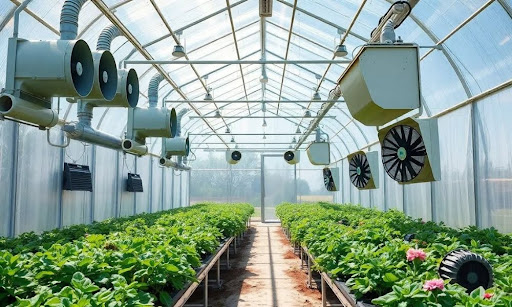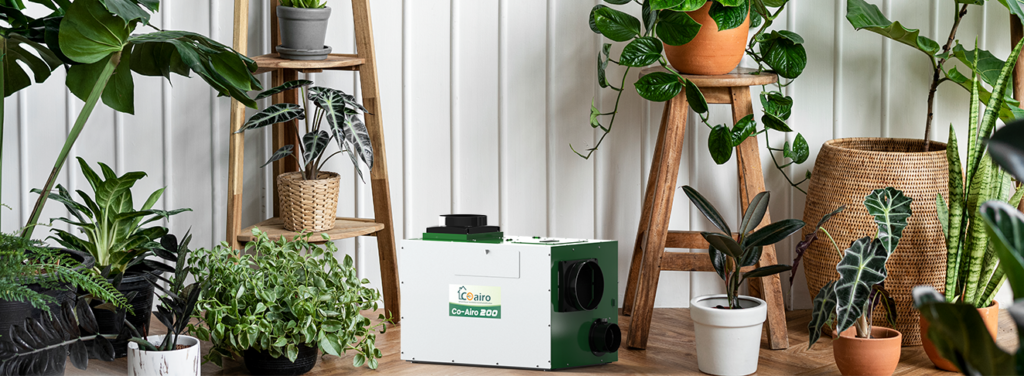Humidity is one of the most critical factors influencing plant growth, health, and yield. In U.S. greenhouses, factors such as dense planting, frequent irrigation, seasonal rainfall, and limited ventilation can push relative humidity (RH) up to 90% or higher.
At first glance, high humidity may seem harmless—after all, plants need moisture to thrive. However, sustained RH around 90% can quietly stress crops, weaken plant structure, and create ideal conditions for disease. This guide explores what happens at 90% humidity, which crops are most sensitive, and practical strategies to bring humidity back under control.
What Happens if the Humidity Reaches 90%?
Reduced Transpiration and Nutrient Uptake
When RH reaches 90%, the vapor pressure deficit (VPD)—the difference between the moisture inside the leaf and the surrounding air—drops dramatically. With a low VPD, plants transpire less. Since transpiration drives water and nutrient flow from roots to leaves, this slowdown limits nutrient uptake and can stunt growth even when the soil is moist. Young plants and seedlings are especially vulnerable; they may show pale leaves, slowed growth, or nutrient deficiencies despite regular fertilization.
Weakened Plant Structure
High humidity often stimulates lush, rapid vegetative growth, but that growth is structurally weak. Constant turgor pressure under high RH prevents the normal hardening of cell walls, resulting in thinner leaves, elongated stems, and fragile tissues. Plants may look tall and healthy at first but are prone to bending, lodging, or tearing under irrigation spray or wind. Over time, this weak architecture can reduce overall yield quality.
Increased Disease Risk
Fungal and bacterial diseases flourish when RH exceeds 85%. Prolonged leaf wetness allows spores of pathogens such as Botrytis cinerea (gray mold), Powdery mildew, and downy mildews to germinate and spread rapidly. Dense planting further traps moisture within the canopy, creating microclimates where fungi thrive. Once infection begins, yield losses and quality reductions can be severe, often requiring costly chemical or biological control.
When Does High Humidity Usually Occur in U.S. Greenhouses?
High humidity often builds up due to a combination of weather and greenhouse management factors:
Summer and Late Spring
In southern regions such as Florida, Louisiana, and Texas, warm outdoor air is already saturated with moisture. Even with open vents, greenhouses easily trap high RH levels.
Winter and Early Spring
In northern states, vents are closed to conserve heat. Moisture from plant transpiration, wet soil, and condensation accumulates quickly inside.
Rainy Periods
Extended rainfall raises outdoor humidity and allows moist air to enter through doors, vents, and cracks in the structure.

Which Plants Are Most Sensitive to 90% Humidity?
Different crops respond differently to excess humidity, depending on their leaf structure and physiology.
Leafy Greens (Lettuce, Spinach, Arugula)
Highly sensitive. These crops have thin leaves and a large surface area, making them vulnerable to damping-off, downy mildew, and Botrytis infections. Prolonged exposure to 90% RH reduces marketable yield, increases post-harvest decay, and raises disease management costs.
Fruit-Bearing Crops (Tomatoes, Peppers, Eggplants)
Moderately to highly sensitive. While these crops can tolerate brief periods of high humidity, sustained RH above 85% disrupts calcium transport, leading to physiological disorders such as blossom-end rot. Fungal diseases like gray mold and powdery mildew also become more common, reducing both fruit set and quality.
Ornamentals and Tropical Plants (Orchids, Poinsettias, Anthuriums)
Moderately tolerant. Many tropical ornamentals naturally prefer higher humidity, but poor air circulation in greenhouses still encourages fungal leaf spots and bacterial infections. This can lead to discoloration, loss of bloom quality, and lower commercial value.
Seedlings and Cuttings (Propagation Stage)
Extremely sensitive. Propagation zones are high-risk areas where high RH can trigger damping-off, root rot, and fungal invasion. Seedlings require careful environmental control because their tissues are soft, and their defenses are underdeveloped.
How to Deal with 90% Humidity?
Sustained 90% RH is too high for most crops and should be corrected immediately. At this level, plants cannot transpire effectively, condensation appears on surfaces, and fungal spores germinate rapidly.
The goal is to remove moisture efficiently while maintaining stable plant conditions. Here’s how to do it step by step:

Stop Adding Moisture
Immediately pause all overhead irrigation, misting, and fogging systems. Switch to drip or ebb-flow methods that water roots directly without wetting leaves or saturating the air. Check for other hidden moisture sources—such as open water tanks, puddles on the floor, or leaking pipes—and cover or drain them promptly.
Increase Air Exchange
If the outdoor air is drier than the greenhouse air, open vents, louvers, or doors to release moisture. Roof vents are particularly effective since warm, moist air rises naturally. However, if outside RH is also high (during rain or fog), keep vents closed; otherwise, the problem may worsen.
Enhance Internal Air Circulation
Turn on all circulation fans, including HAF (horizontal airflow) systems. Gentle, continuous air movement—enough to lightly rustle leaves—breaks up stagnant moisture pockets around plants. For best results, combine horizontal fans with vertical or ceiling fans to prevent condensation from forming on glazing or metal frames.
Use Mechanical Dehumidifiers
When natural ventilation is not enough, mechanical dehumidification becomes essential.
Choose units sized for your greenhouse volume and crop density—roughly one 30–50 L/day unit for every 400–800 ft² is a good starting point. Place greenhouse dehumidifiers near the most humid zones, such as dense crop rows or central aisles, but avoid blowing directly on foliage. Drain continuously and operate mainly at night or after irrigation, when humidity peaks.
Apply Heat Strategically
Raising temperature slightly (by 1–2°C or 2–4°F) can reduce RH by increasing the air’s moisture capacity. This should always be paired with ventilation or dehumidification to remove the released moisture. Avoid sudden temperature spikes that could stress sensitive crops.

Manage Condensation and Surfaces
Condensation creates localized high-humidity zones that encourage disease. Keep inner glazing surfaces warm using energy curtains or thermal screens. Wipe or squeegee persistent wet spots, and insulate cold metal frames or install anti-drip coatings to prevent droplets from falling on leaves.
Adjust Plant Density and Structure
Overcrowding traps moisture between leaves. Regular pruning, spacing plants properly, and removing senescent leaves improve airflow and reduce disease risk. Avoid overfertilization, which promotes soft, dense foliage that retains humidity.
Isolate Sensitive Areas
Propagation areas and seedling trays should be kept separate whenever possible. Maintain slightly lower humidity (around 70–80%) with independent fans or small dehumidifiers. If the main greenhouse becomes too humid, move vulnerable plants to a controlled, drier environment temporarily.
Monitor Continuously
Humidity management is a continuous process, not a one-time fix. Install reliable RH and temperature sensors at multiple heights—near the canopy, mid-level, and near the roof. Monitor VPD as well as RH, since VPD better reflects plant comfort and transpiration potential. Recording daily data helps identify trends and prevent future spikes.
Conclusion
Sustained 90% humidity is generally too high for most greenhouse crops. It suppresses transpiration, weakens plant structure, and accelerates disease outbreaks. The optimal RH range for most crops lies between 50% and 70%, though tropical species may tolerate slightly higher levels.
Combining ventilation, air circulation, heating, and Coairo greenhouse dehumidifier is the most reliable way to restore a balanced greenhouse climate. Preventive measures—such as monitoring humidity, managing irrigation, and maintaining airflow—are always more effective than reactive fixes.
In short, controlling humidity is not just about plant comfort—it’s about protecting your yield, reducing disease pressure, and ensuring long-term greenhouse efficiency.


